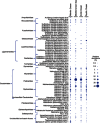Virus-mediated archaeal hecatomb in the deep seafloor
- PMID: 27757416
- PMCID: PMC5061471
- DOI: 10.1126/sciadv.1600492
Virus-mediated archaeal hecatomb in the deep seafloor
Abstract
Viruses are the most abundant biological entities in the world's oceans, and they play a crucial role in global biogeochemical cycles. In deep-sea ecosystems, archaea and bacteria drive major nutrient cycles, and viruses are largely responsible for their mortality, thereby exerting important controls on microbial dynamics. However, the relative impact of viruses on archaea compared to bacteria is unknown, limiting our understanding of the factors controlling the functioning of marine systems at a global scale. We evaluate the selectivity of viral infections by using several independent approaches, including an innovative molecular method based on the quantification of archaeal versus bacterial genes released by viral lysis. We provide evidence that, in all oceanic surface sediments (from 1000- to 10,000-m water depth), the impact of viral infection is higher on archaea than on bacteria. We also found that, within deep-sea benthic archaea, the impact of viruses was mainly directed at members of specific clades of Marine Group I Thaumarchaeota. Although archaea represent, on average, ~12% of the total cell abundance in the top 50 cm of sediment, virus-induced lysis of archaea accounts for up to one-third of the total microbial biomass killed, resulting in the release of ~0.3 to 0.5 gigatons of carbon per year globally. Our results indicate that viral infection represents a key mechanism controlling the turnover of archaea in surface deep-sea sediments. We conclude that interactions between archaea and their viruses might play a profound, previously underestimated role in the functioning of deep-sea ecosystems and in global biogeochemical cycles.
Keywords: Deep-sea ecosystems; archaea; bacteria; biodiversity; ecosystem functioning; microbial loop; virus-host interactions.
Figures







References
-
- Fuhrman J. A., Marine viruses and their biogeochemical and ecological effects. Nature 399, 541–548 (1999). - PubMed
-
- Weinbauer M. G., Ecology of prokaryotic viruses. FEMS Microbiol. Rev. 28, 127–181 (2004). - PubMed
-
- Suttle C. A., Review viruses in the sea. Nature 437, 356–361 (2005). - PubMed
-
- Suttle C. A., Marine viruses—Major players in the global ecosystem. Nat. Rev. Microbiol. 5, 801–812 (2007). - PubMed
-
- Danovaro R., Dell’Anno A., Corinaldesi C., Magagnini M., Noble R., Tamburini C., Weinbauer M., Major viral impact on the functioning of benthic deep-sea ecosystems. Nature 454, 1084–1087 (2008). - PubMed
MeSH terms
LinkOut - more resources
Full Text Sources
Other Literature Sources

